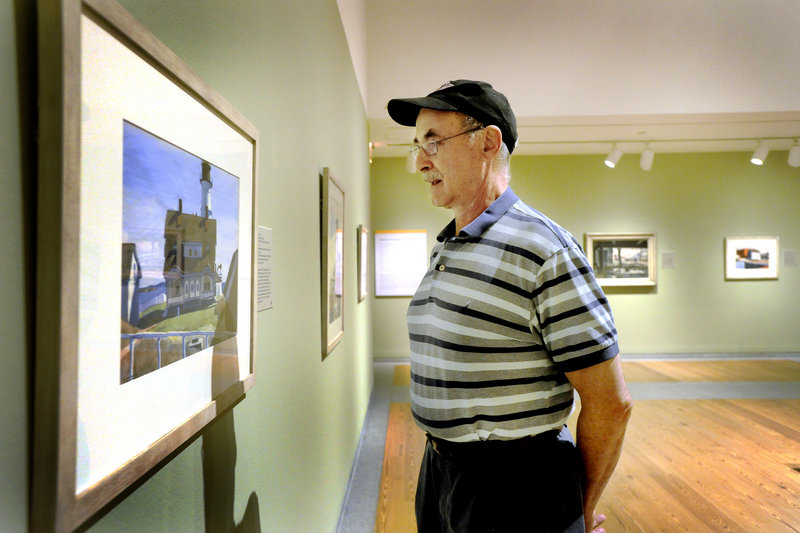PORTLAND – On Thursday, 200 of Maine’s leaders in the arts will meet with the president of the Kennedy Center for the Performing Arts to talk about the arts crisis in America.
Michael M. Kaiser will discuss the role and the survival of arts institutions during the economic downturn and address pressing concerns such as budget cuts and effective leadership.
The irony of the event, ominously titled “Arts in Crisis,” is that it will be held at the Portland Museum of Art, Maine’s flagship cultural institution, which happens to be in better financial shape than most other arts groups in Maine and is riding out the economic storm by strengthening its board, bolstering programming to encourage membership growth and planning for a future that likely will include expansion.
Last week, the museum opened “American Moderns,” an exhibition of watercolors by Edward Hopper, John Marin and other modernist masters, many of whom painted in Maine in the early 20th century.
The summer show, on loan from the Wadsworth Atheneum Museum of Art in Hartford, Conn., is on view in tandem with a Winslow Homer watercolor exhibition on the second floor.
Together, the broad appeal of “American Moderns” and “Winslow Homer and the Poetics of Place” should usher in a wave of visitors — both local and tourist-driven — that museum officials hope will help it to another banner attendance year.
Just shy of 162,000 people visited the museum during the last fiscal year, which closed Jan. 31. That’s the second-highest attendance at the museum, eclipsed only by the 188,000 people who visited in 2000.
Attendance is good, and so is the economic outlook, relatively speaking. The museum closed the fiscal year with a balanced budget of about $4.6 million, thanks in part to increases in three key member categories — individuals, the young Contemporaries group and the high-dollar donors on the Committee of 100. The current operating budget is nearly identical to last year, at $4.6 million.
The museum also integrated a new director, Mark H.C. Bessire, who completed his first year in March after replacing former Director Daniel E. O’Leary.
Bessire inherited a healthy institution, but one that was caught in a deepening recession. The museum’s endowment, which once topped $36 million, dipped to a low of $22 million in 2009, forcing the layoff of six staff members. But the worst fears of 2009 were not realized, thanks largely to strong attendance.
“A good sign of a healthy institution is that when times are not good, your supporters stay with you. The people stayed with us when their support was most needed,” Bessire said.
As an endorsement of his leadership, the museum board recently approved a five-year plan submitted by Bessire and a museum planning committee. The plan fine-tunes the museum’s mission and attempts to improve the effectiveness and reach of its governing board, while devising strategies to develop new donors by adding staff to the development department.
The plan also includes a working blueprint for the integration of the museum-owned Winslow Homer studio — located in Scarborough’s Prouts Neck neighborhood — into the museum’s mission and programming. The studio is in the process of being restored to its condition when Homer painted there, and work on that project will continue for at least another year.
The Homer project is the focus of an ongoing fundraising effort at the museum. The original goal was to raise $6 million, but that figure has been increased to $10 million, said James Moody, past board president.
The plan does not specifically address the future of two properties owned but undeveloped by the museum — the Clapp House next door at 97 Spring St., which the museum reacquired from Maine College of Art in 2008; and the now-vacant former YWCA property at 87 Spring St. The museum acquired that property in 2007.
While the new five-year plan does not address either property directly, Moody said the museum’s board has both pieces in its longer vision.
In an agreement with the city, the museum has 20 years to develop the 87 Spring St. property, Moody said. “Not much has been done yet in that regard, because there are so many other things the museum has been working on. That is not to say it’s off the radar. It isn’t,” he said.
Similarly, any effort to redevelop the Clapp House also is likely several years away. The museum envisions the Clapp House, an 1832 Greek Revival structure, being integrated with the existing museum building, with a physical link.
Such a plan would be “very expensive, and that is not something we could really undertake at this time. You would need to mount a significant fundraising campaign, and now is not a good time to be doing that,” Moody said.
Hilary Robbins, a member of the museum board and the board’s strategic planning committee, said the five-year plan capitalizes on the museum’s strengths and challenges it to move forward with sustainable growth. She is confident about the museum’s future.
“We weathered the economic downturn well compared to a lot of other institutions. So now we’re going to capitalize on the museum’s strong assets, as well as the energy around the artistic community in Maine right now, and make them work to everyone’s benefit,” said Robbins.
“We want to draw more donors and a larger audience to give the PMA the opportunity to tell the story of Maine art and Maine’s role within American art to the nation,” she said.
Staff Writer Bob Keyes can be contacted at 791-6457 or at:
bkeyes@pressherald.com
Send questions/comments to the editors.



